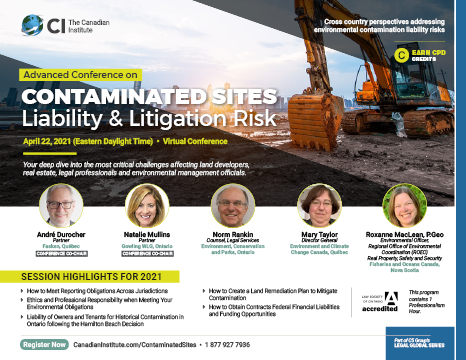Agenda

Discover why this is a must-attended event to gain cross country perspectives addressing environmental contamination liability risks.
VIEW FULL BROCHURE** Session not recorded
- Jump to:
- At a Glance
- Day 1
- Print-friendly Format
Day 1
Day 1
| 8:30 |
Remarks from the Co-Chairs Natalie Mullins  André Durocher  Bryan J. Buttigieg |
| 8:40 |
How to Meet Reporting Obligations Across Jurisdictions When a Contamination is Discovered and Exploring the Consequences of Not Reporting Norm Rankin  Warren Rospad  Maylia Kempt Parker  Jonas Fenn B.Sc. PAg.
|
| 9:30 |
Ethics and Professional Responsibility when Meeting Your Environmental Obligations Matt Benson This session can be applied to 1 Professionalism Hour(s) with the LSO.
|
| 10:30 |
Break |
| 10:45 |
Mitigating Legal Negligence and Liability when Buying and Selling a Contaminated Property Arnie Herschorn
|
| 11:45 |
Liability of Owners and Tenants for Historical Contamination in Ontario following the Hamilton Beach Decision Paul McCulloch  Joanna Rosengarten A look at Ontario’s Divisional Court ruling on Hamilton Beach Brands Canada Inc. v. Ministry of the Environment and Climate Change, (2018 ONSC) which decided the current occupants of a property can be found responsible for historical contamination that spreads to neighbouring sites.
|
| 12:45 |
1:1 Networking with Speakers and DelegatesMake new connections, face-to-face. Troubleshoot top pain points and share breakthrough strategies using an interactive virtual feature that will introduce you to fellow industry leaders for a quick conversation. |
| 12:55 |
Break |
| 1:30 |
Contaminated Sites Litigations: Who is at Fault? What is the Extent of Liability? How to Prove Damages? André Durocher
|
| 2:30 |
Recovering Remediation Costs Bryan J. Buttigieg  Kinji C. Bourchier
|
| 3:30 |
Break |
| 3:45 |
CASE STUDY:Risk Management of Light Non-Aqueous Phase Liquid (LNAPL) at Kraut Point Small Craft Harbour, Nova Scotia Derek AuCoin  Roxanne MacLean, P.Geo A look at the government process and remediation of Light Non-Aqueous Phase Liquid (LNAPL) at Kraut Point Small Craft Harbour, Riverport, Lunenburg County, in Nova Scotia.
|
| 4:30 |
How to Obtain Contracts Federal Financial Liabilities and Funding Opportunities ** Ian Chatwell  Mary Taylor The Federal Contaminated Sites Action Plan (FCSAP) has earmarked $1.16 billion to be spent by 2024 to reduce environmental and human health risks from known federal contaminated sites and associated. This session will examine how the funding is being allocated and lessons learned from contaminated land remediation case studies. |
| 5:00 |
Lessons Learned from Legacy Uranium Mine Remediation on Crown Land ** David Sanscartier, P.Eng, PhD |
| 5:30 |
Closing Remarks from the Conference Co-Chairs |